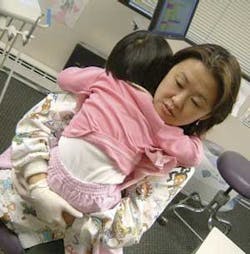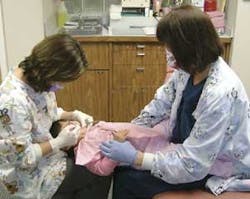The Kids Are Coming!
Techniques and strategies for positive dental experiences.
Your patient, Johnny, is the one-year-old healthy son of one of your patients. The mother says, “I see a brown spot on his tooth, but he is only one. I hope he doesn’t have a cavity. Could you look at it for me?”
You say to yourself, “Oh, no!” and quickly review your options. You (a) don’t even attempt to look and tell her to take him to a pediatric dentist (b) attempt to look, but become nervous at the screaming and you don’t get a good look. Tell the mother they’re only baby teeth and they will fall out anyway. (c) do not look and tell the mother her child is too young to treat even if he does have cavities or (d) do an exam, allow the baby to scream, but get a good look at the teeth.
According to the American Academy of Pediatric Dentists, in 2003 there were 4,524 active licensed pediatric dentists in the United States. To compare, two years ago there were approximately 60,000 practicing pediatricians! This means there are not enough pediatric dentists to go around, and that the majority of children are being treated or should be treated and examined by dentists just like you. As of December 2003, the American Dental Association reported there were 139,934 licensed general dentists in the country. This number does not include retired or residents in post-graduate programs.
In other words, the average, well-behaved child should be seeing you, the general practitioner, for comprehensive dental care. But with a little effort on your part, you could also be treating that overly active child. That is not to say there isn’t a need for pediatric dentists for the more rambunctious, active, or spirited children, or for the children with more complicated or involved clinical situations. So what’s stopping the general dentist from treating children? Perhaps it’s fear, lack of confidence due to inexperience, or an educational void.
Perhaps economics is the issue because of the myth, “You can’t make a living treating children.” Historically, pediatric training in the predoctoral program of most dental schools is not stressed as it should be. Pediatric dentistry is usually something students get through in order to graduate. When the opportunity to learn pediatrics was available in school, many students’ experiences were so negative that they became afraid of kids and decided never to see another child again.
Today’s dental focus seems to be on the so-called “glamour stuff” - dentures, complete oral rehabilitation, crowns, bridges, and, of course, cosmetics. Then, when a patient asks you to look at her child’s teeth, your heart goes into a spasm.
Treating children is one of quickest and easiest ways to kick-start your practice. So as with any other clinical discipline, it behooves you to brush up on the techniques that will give you the expertise and confidence to treat children effectively and competently. What can you do to refresh your memory on how to do a stainless steel crown, how to complete a pulpotomy, or do a lap-to-lap exam? The answer is continuing education, a great thing! There are now Web casts by AAWD, where you can learn a new technique in the comfort of your own home, and DVDs on how to restore teeth with stainless steel crowns produced by Drs. Berman and Kollmann. All is not lost!
Know your limitations in behavior management and dental technique. In other words, if you choose to refer the “spirited” child to a pediatric dentist, explain the situation to the parent when you give the referral. Have confidence in the person you are referring to and you will gain the trust of the parent. Call the pediatric dentist about specific concerns and let the parent know you are placing their most prized possession in the hands of someone you trust. You will certainly be a hero and you don�t have to lift a handpiece. As far as the money is concerned, you have reinforced your relationship with the parents, who will now refer their friends to you and eventually the child will return to you with their children in tow!
Our future is looking bright. Due to the overwhelming need for children’s care, dental schools are changing their curriculum to teach dental students how to perform lap-to-lap exams. Well-baby checks should be performed at age one, most importantly for educating the parent on nursing bottle caries, brushing, breastfeeding, and to answer any questions they may have. How often do you find it difficult to get your patients to realize the importance of proper dental health? How often do we neglect our own health for the health of our children? All the time! Parents will test you with their children. Parents often say to me, “I wish you took care of adults.” In demonstrating how good I am with their children, they want me to care for them as well. So let me encourage you to make the leap and see how doing the amalgam or occlusal composite in a child can be just as rewarding as that three-unit bridge you’re delivering in an adult. And remember, something as simple as educating first time parents who are your patients about the dangers of nursing bottle caries can create a lifetime of healthy smiles that will return to your office time and time again!
Now let me return to the opening scenario. If you chose (b) or (c), you must “go directly to jail, do not pass go and do not collect $200.” If you chose (a) or (d) and performed an exam, you win the game!
What you may notice is not caries, but stain across the lingual and labial surfaces of the anterior teeth. After a review of the medical history, which states nothing, you ask the mother if Johnny is on any type of vitamin. She reveals that he takes iron drops, so you explain that iron drops cause staining on the teeth, and you remove the stain. The mom is happy, Johnny is happy to go home, and you are happy because you accomplished something very easy that many other general dentists are afraid to try. What you realize is that just because Johnny was crying did not mean you were hurting him or doing something wrong. Babies cry when they don’t like something. You taught the mother that you were helping her baby, giving her relief, and that he does not have cavities. Most of all, you gained her trust!
Once you start treating children you will realize that whether they are two, 10 or 17, children are wonderful to have as part of your practice! Not only will they give you a personal sense of satisfaction, but they are often nicer and more fun to talk to than adults! As far as the business aspect, treating children can give life and rejuvenate an existing practice, or plant the seeds for a new practice. That one-year-old boy will one day be a man who may have children of his own, as well as friends with children. You get the picture. Treating children should not be an option, it should be a necessity. Tomorrow morning when you see that one year-old boy on your schedule, you’ll say to yourself, “I can do this!”
null
Dr. Cissy K. Furusho is President of the AAWD; a partner in pediatric office, practicing full-time in Chicago; she also teaches one day a week at the University of Illinois College of Dentistry in the department of pediatric dentistry. Dr. Furusho can be contacted at [email protected].



